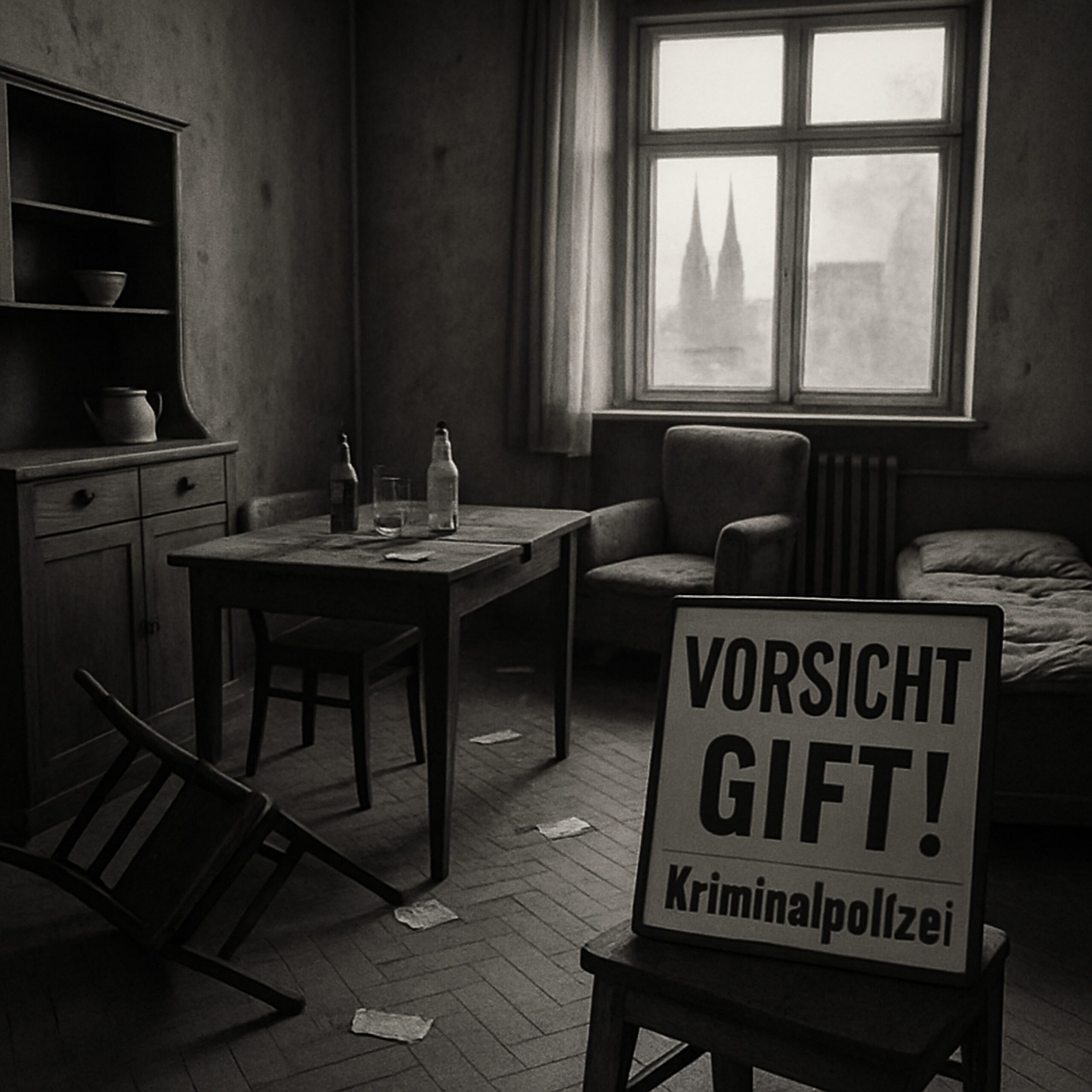The last death penalty in Germany was imposed on April 21, 1949, in Cologne, and it was handed down to 38-year-old serial killer Irmgard Swinka, a woman who attracted a great deal of attention in the postwar period. Within 12 months, she had killed five elderly women. Irmgard was born in Berlin in 1912. She grew up at a time when life was anything but easy. Her father was a violent alcoholic, which made family life hell for little Irmgard. School was nothing but a place of failure for Irmgard, and she broke off contact with her siblings, which further isolated her. The years passed and Irmgard became known to the police for her criminal activities, including theft, fraud, and embezzlement. Irmgard had already been married twice before she married for the third time. However, her third husband was still married, which is why both were charged with bigamy. For these reasons, the couple went into hiding for the first time. Despite all these difficulties, Irmgard somehow managed to keep her head above water in the chaotic post-war period. In a Germany where shops were empty and the Reichsmark was worthless, she found ways to survive on the black market. Together with her partner, she lived a relatively luxurious life compared to many others. They exchanged stolen goods for everything they needed to live, even real coffee beans. For many, this was a rarity at the time. For Irmgard, crime seemed to be a means to an end, a way to survive in a harsh world. But her penchant for crime led Irmgard into much darker territory. Together with her accomplices, 30-year-old Wilhelm Schmikahle and 43-year-old Ernst Himpel, she committed robberies. The trio infernale always proceeded according to the same modus operandi. They traveled to large cities, where Irmgard specifically sought out older, lonely women. She presented herself as a helpful person who supposedly had good medical advice. Irmgard offered these women supposed “special mixtures” that she claimed to have obtained from a fictional pharmacist father. The reality, however, was that she administered a lethal mixture of Noctal sleeping pills and morphine drops to her victims. She had acquired this poison cocktail from a former SS medic in a refugee camp. When the women lost consciousness, Irmgard ransacked their homes for items that she could sell on the black market. Meanwhile, the two men stood guard. The cruel method was successful. More than 40 pensioners fell victim to these brazen robberies. Five of them did not survive, including the last victim, 63-year-old Helene Schmitz, who was poisoned in Cologne in June 1948. Ms. Schmitz’s death finally triggered a wave of investigations. A police officer suspected that something was amiss. He discovered traces of poisoning, which set the case in motion. Investigations revealed that Helene Schmitz had been visited by an elegantly dressed lady before her death. This description of the lady matched those of the robberies in other cities. A wanted poster was produced. After newspapers published a picture of Irmgard Swinka, she was arrested in Hamm on July 13, 1948, thanks to a passerby who recognized Irmgard as the woman in the wanted poster. The media pounced on the insidious “poisoner” who had poisoned old ladies out of greed. Her trial became a sensational event in post-war Germany. On April 21, 1949, the trial began at the Cologne Assize Court. Irmgard, who was described as an unpleasant woman with a coarse face, was charged with five counts of murder and 10 counts of attempted murder. During the trial, 235 witnesses and 40 experts were heard. The indictment was 257 pages long. Irmgard herself gained 20 kilograms while in pretrial detention and told fellow inmates that she had devoted herself to Satan. Her aim was to be deemed mentally incompetent. But this plan did not work. Throughout the trial, crowds gathered outside the courtroom, trying to catch a glimpse of the notorious poisoner Irmgard Swinka. On May 7, 1949, the verdict was finally handed down: four death sentences, one life sentence, and an additional 15 years in prison. The verdict described her as insidious and warned against her exploitation of the elderly women’s trust. But fate had other plans. Just a few weeks after the verdict, the Basic Law came into force, abolishing the death penalty. Irmgard Swinka’s sentence was thus commuted to life imprisonment. She spent the next 38 years of her life behind bars. She shared her cell with her budgies “Bubi” and “Mekki” until she was pardoned in 1987 under Prime Minister Johannes Rau. Under the false name Moser, she was released and taken to a retirement home near Aachen. In the eyes of the public, the story of the poisoner was over, but for Irmgard, a new chapter began. In 1988, she finally died of a heart attack at the age of 76 in a retirement home near Aachen. Only the home’s director knew her real name, while most people only knew the shocking story of a woman who had taken five lives with cunning and poison. Irmgard Swinka’s criminal case is shocking, but also fascinating, and at the same time a reminder of how deep the human abyss can be, even at a time when many were striving for peace and normality.
By Isabella Mueller
Welcome to my journey through creativity and discovery! My name is Isabella Mueller, and I invite you to explore the fascinating creative universes I create through my blogs. Since 2020, I have been dedicating my passion to telling captivating stories that are mysterious, historical, and emotional. My goal is not only to entertain, but also to inspire reflection and awaken the spirit of discovery in each of us. At isabellas.blog, the suspense of crime stories is combined with exciting travel tips. Imagine wandering through the picturesque streets of a new city, uncovering dark secrets hidden in the shadows of its history. Every piece on my blog is designed to make the heart of every crime fiction fan beat faster while sparking curiosity about unknown places. Here, you are invited to experience the thrill of the unknown and the beauty of our world—a perfect combination for all adventure seekers! My second blog, akteq.com, is all about true, unsolved crime stories. Under the motto “akteQ: Cold Case Stories,” I reveal the eerie and often tragic stories behind unsolved cases. Together, we can explore the mysteries of the past and delve deep into the human psyche. What really happened? Who were the people behind these mysterious events? In this blog, I invite you to ask questions and find the answers that often remain hidden in the dark. You can find another exciting chapter in my blogging career at thecastles.org. Here, I embark on an enchanting journey through the history of castles and palaces. Pause for a moment as you discover the stories hidden within the walls of these ancient structures. “Explore the enchantment, discover the history – your journey begins at thecastles.org!” These words are more than just a slogan; they are an invitation to anyone who wants to combine history and magic. Be inspired by the impressive stories and the fascination of bygone eras! But that's not all! At kripo.org, you'll find a comprehensive online magazine for real criminal cases. Immerse yourself in the world of crime, learn about the real stories behind the headlines and the people who are involved in solving them. With criminal.energy, I take you on a journey through the gripping stories of true crimes in which villains are hunted, caught, and convicted. The search for justice and the confrontation with the unknown are at the center of it all. TrueCrime Blog 187.news takes you into the depths of crime. And for those who want to travel the world, wanderlust.plus offers the opportunity to explore the world, one adventure at a time. It's all about the love of exploration and the joy of discovering new cultures and landscapes. Finally, truecrime.ch invites you to discover the dark side of Switzerland and Europe: true crimes, true stories. Let's discover together the stories that shape the world around us. I look forward to accompanying you on this exciting journey and hope you will share many unforgettable moments with me!

